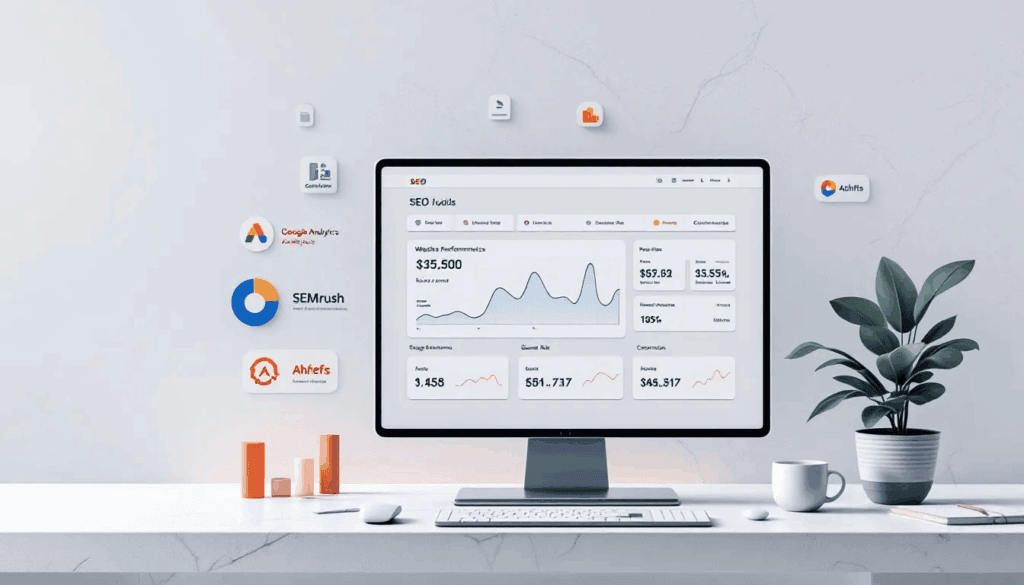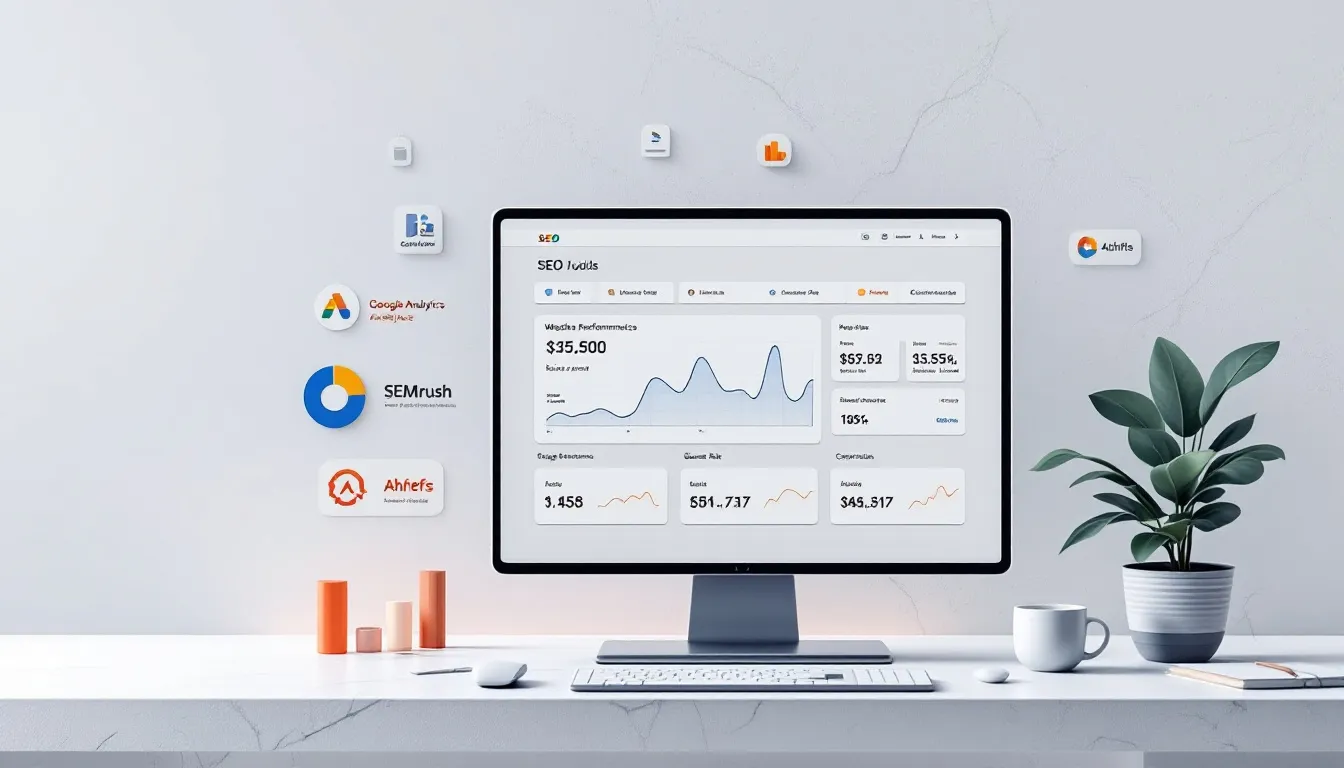Top Tools and Methods for Analysing Websites Effectively

Analysing websites is essential for improving user experience and increasing conversions. This article covers the best tools and methods for analysing websites to help you understand your site’s performance and make data-driven decisions.
Key Takeaways
- Website analysis is essential for understanding user behavior and improving conversion rates, highlighting the impact of actionable analytics on business strategies.
- Key performance metrics such as conversion rates, traffic analysis, and engagement metrics are critical for optimizing website performance and user experience.
- Utilizing both traditional and advanced analytics tools, along with user feedback, enhances insights into website effectiveness, guiding strategic decision-making.
Understanding Website Analysis

Analysising websites involves examining and testing a website’s performance. It also includes optimizing the site for better results. It’s a critical tool for evaluating online effectiveness, influencing marketing strategies, and enhancing user engagement. This process involves collecting and evaluating data about website users, which helps businesses understand how visitors interact with various elements on the site.
Understanding user behavior is crucial for improving user experience, which can directly influence conversion rates. For example, if visitors frequently abandon their carts, it might indicate a problem with the checkout process. Analyzing how users behave helps businesses identify and rectify issues, improving user experience, increasing traffic, and boosting conversion rates.
Combining data analysis with domain expertise enhances insights, providing context that might not be evident from data alone. Actionable analytics involves using insights derived from various data sources like website metrics and customer feedback to inform business strategies. Focusing on the most relevant data aligns with business goals, prioritizing information likely to drive actionable outcomes.
Key Metrics for Website Performance

Identifying and monitoring key metrics is vital for optimizing a website’s performance. Conversion rate, for instance, measures how effectively a website turns visitors into customers or leads. Google Analytics can be instrumental in achieving significant improvements; for example, Lider experienced an 18X improvement in conversion rate using Google Analytics.
Traffic analysis helps monitor visitor volume and activity, determining successful pages and overall traffic performance. Engagement metrics, including views per user and average session duration, provide essential insights into user behavior and important flows. Specsavers saw a 33% boost in conversion rate after optimizing their site speed, highlighting the impact of these metrics on website’s performance.
Key website metrics include:
- Bounce rate: tracks the percentage of visitors who leave after viewing only one page.
- Top exit pages: identifying these can provide insights into user experience issues or content relevance.
- Traffic sources: understanding these helps website owners identify visitor origins and optimize marketing strategies.
Traditional Website Analytics Tools
Traditional website analytics tools are essential for understanding website performance, user behavior, and marketing effectiveness. Traditional analytics, such as Google Analytics, is widely used for providing insights into user acquisition and engagement. Google Analytics 4, specifically, offers detailed, sharable reports that enhance understanding of visitor behavior.
Here are some traditional analytics tools and their key features:
- Kissmetrics: includes advanced reporting, such as cohort analysis, to track user behavior over time.
- Plausible Analytics: offers a user-friendly interface focused on essential web performance metrics.
- Adobe Analytics: enables predictive analysis, helping businesses forecast trends based on customer analytics data.
Here are some key features of different analytics tools:
- Fathom Analytics: emphasizes user privacy, protecting data from exploitation for marketing purposes.
- Woopra: features customer journey reports that visualize user interactions over time.
- Matomo: an open-source tool that emphasizes data protection and customer privacy, giving businesses full data ownership.
Collectively, these tools enhance the insight into user interactions and behavior across sites and websites, providing a comprehensive suite of features.
SEO Audits and Tools

SEO audits analyse website performance on search engines and optimize pages accordingly. Tools like Ahrefs and SEMRush are crucial for thorough seo audit to identify and resolve issues. Ahrefs provides an extensive breakdown of site audits, offering multiple categories for granular analysis to enhance performance.
Screaming Frog’s free version audits up to 500 URLs, checking elements like broken links and metadata. SEMRush offers a comprehensive audit tool that tracks SEO progress over time, providing detailed insights into issues.
Utilizing these seo tools effectively can greatly enhance a website’s visibility and search engine rankings.
Behavior Analytics Tools
Behavior analytics tools capture user actions on websites, revealing interaction patterns and user experiences. Contentsquare is an Experience Intelligence platform that integrates traditional web analytics with behavior analytics and content analytics software, offering AI capabilities that quickly surface essential insights. Integrating behavior analytics with traditional web analytics enhances user data analysis.
Heatmap tools visually represent user engagement, highlighting the most and least interacted elements. Hotjar is a popular tool for tracking user behavior through heatmaps and visual behavior insights. Session replays tools allow visualization of user actions, helping to identify points of confusion or frustration.
Qualitative data from behavior analytics tools reveals user experiences and engagement insights, informing decision-making. These tools help you understand user behavior on the website, providing qualitative data and quantitative data that informs decision-making.
User Feedback and Testing
User feedback is invaluable for understanding how customers interact with a website. Feedback and VoC feedback tools enable direct user input, helping to clarify reasons behind user behavior and site interactions. User feedback surveys provide immediate insights into user experiences, helping developers identify specific usability issues.
Post-task surveys offer several benefits:
- Capture immediate reactions and identify usability issues right after task completion.
- Anonymity in surveys encourages honest responses, leading to accurate feedback on user experiences.
- Real-time data enhances customer satisfaction by enabling immediate responses to client needs and preferences.
Customer journey mapping visually represents all interactions and touchpoints a customer has with a website, allowing for a deeper understanding of their experience. Creating data-driven personas is essential in customer journey mapping, as they help identify customer motivations and needs based on actual data.
Competitive Analysis

Understanding competitors is crucial for effectively capturing your target audience’s attention. Monitoring competitors can provide invaluable insights that inform strategic decisions for business growth. Effective competitive analysis results in actionable strategies, helping brands stay ahead in their industry.
SEMRush includes features for competitor analysis and market insights, making it versatile beyond traditional web analytics. SimilarWeb is a competition and market analysis platform tracking online traffic data, analyzing site performance globally, and connecting with qualified leads. Utilizing AI-powered tools can automate the gathering of competitor insights, streamlining the analysis process.
Competitive analysis aims to identify competitors and uncover opportunities and advantages. Third-party/off-site insights tools are necessary for effective competitive analysis.
Mobile and Cross-Device Analysis
Tracking device types can help assess how well a website performs across different devices and platforms, informing design decisions. Mobile website testing guarantees optimal performance and user experience across various mobile devices and browsers. Testing on real devices offers the most accurate assessment of website performance in actual mobile environments.
Responsive design is vital to maintaining a consistent user experience across different locations, screen sizes, and devices. Geo-location testing ensures that websites deliver relevant content based on the user’s location on mobile devices.
Real-Time Analytics and Alerts
Real-time analytics processes data immediately as it is generated, allowing businesses to access the latest insights without delays. Continuous real-time analytics provides uninterrupted data processing, ensuring businesses receive timely updates on user behavior and site performance.
Real-time analytics offers several advantages:
- Quick identification of business issues, enabling proactive responses to challenges.
- Automated alerts that notify businesses of critical metrics, such as sudden sales drops or security threats.
- Facilitation of immediate action in response to alerts.
Advanced Techniques for Comprehensive Analysis

Advanced techniques offer a holistic understanding of website performance. Persona analysis helps understand user behavior and informs decision-making. User personas are built by gathering psychographic and demographic data, analyzing it, and developing semi-fictional characters that represent real users.
Understanding the motivations, fears, and concerns of ideal users through personas is key for effective design. Contentsquare’s Product Analytics offers deep user behavior insights, tracks multi-session journeys, and helps identify patterns to improve conversion and retention, providing key insights to create a better user experience.
User interviews provide nuanced feedback on engagement and needs, essential for refining the customer journey. Analyzing key metrics allows businesses to tailor market research content marketing to attract more customers and better meet user needs and expectations.
Integrating Insights for Actionable Results
Key components for effective data-driven decision-making include:
- A centralized data repository to integrate insights from various tools for actionable results, facilitating easier analysis and pattern identification.
- Cleaning and preprocessing data to ensure accuracy and consistency across datasets before integration.
- Real-time analytics to enable effective implementation of dynamic pricing strategies, allowing companies to adjust prices based on current market demands.
Real-time analytics facilitates comprehensive event monitoring, allowing businesses to track promotions and product launches instantly. Real-time analytics increases operational efficiency by automating processes and reducing manual errors to save time. A/B testing tools evaluate different website variations to determine which performs better in user engagement and conversion.
Recommendations for website adjustments, based on customer journey analysis, prioritize changes that enhance user experience and the most important flows. Visualization techniques effectively communicate insights, making it easier for decision-makers to understand and act upon data.
Summary
The journey to understanding and optimizing website performance is a multifaceted one. This guide has covered the essential tools and methods, from traditional analytics to advanced techniques, that can transform how businesses approach their digital presence.
By focusing on actionable insights and continuous improvement, businesses can enhance user engagement, drive conversions, and stay competitive in the ever-evolving digital landscape. Embrace these strategies and tools, and watch your website become a powerhouse of performance and success.
Frequently Asked Questions
What is website analysis?
Website analysis involves evaluating and enhancing a website’s performance to gain insights into user behavior and optimize the overall user experience. This process is essential for improving site effectiveness and engagement.
Why are key metrics important for website performance?
Key metrics are crucial for website performance as they offer valuable insights into how well a site engages visitors and drives conversions. By monitoring these metrics, you can make informed decisions to optimize your website for better results.
What tools are used for SEO audits?
For effective SEO audits, tools such as Ahrefs, SEMRush, and Screaming Frog are essential to identify and resolve performance issues. Using these tools can significantly enhance your website’s visibility in search engines.
How do behavior analytics tools differ from traditional analytics tools?
Behavior analytics tools differ from traditional analytics tools by focusing on capturing user actions and providing qualitative insights into user experiences, whereas traditional tools concentrate on quantitative data and performance metrics. This distinction allows organizations to understand user behavior more deeply.
How can real-time analytics benefit my website?
Real-time analytics can significantly enhance your website by providing immediate insights and automated alerts, enabling you to swiftly address issues and improve both operational efficiency and user experience.

